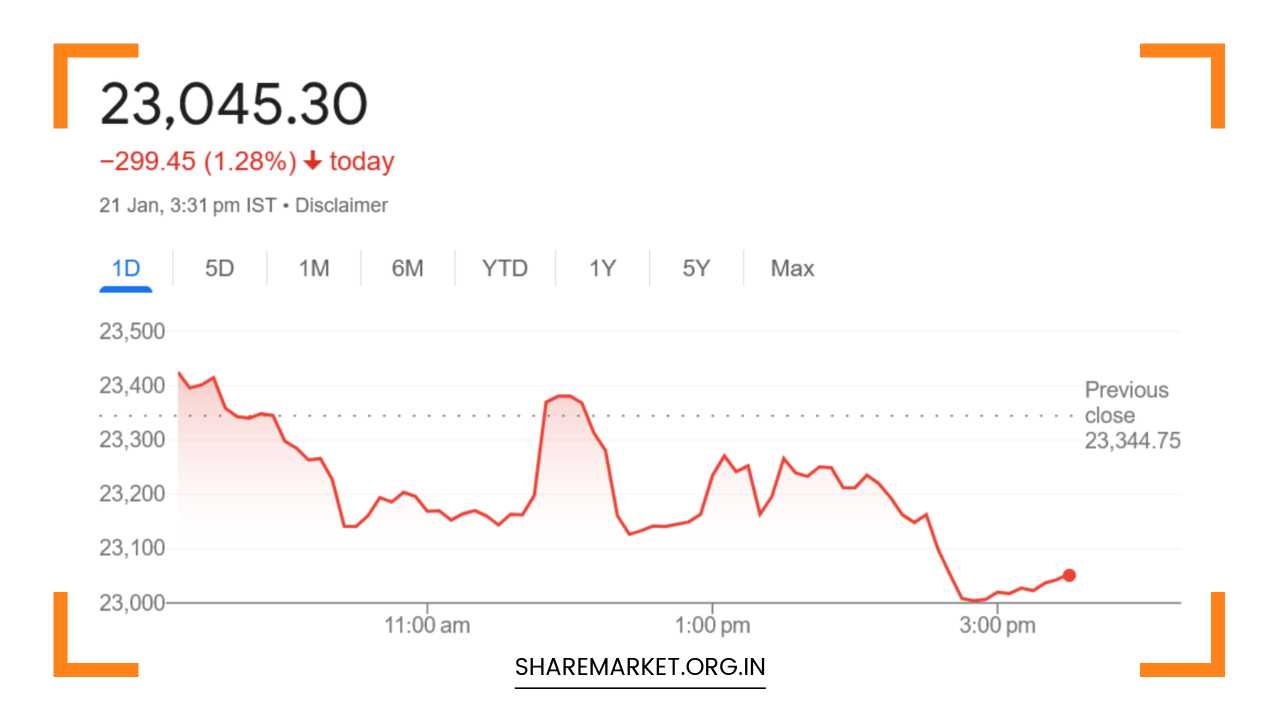Sensex Down 1,235 Points, Nifty at 23,045; Tomorrow Nifty Prediction

Tomorrow Nifty Prediction
Stock Market Ends with Sharp Decline: What to Expect on January 22
The Indian stock market ended on a negative note on January 21, with a substantial decline across all major indices.
Despite a positive start, the market could not maintain momentum, and investor sentiment soured as the day progressed.
A combination of factors, including heavy selling pressure across various sectors, led to a steep fall in the key indices.
Here’s a comprehensive breakdown of the market’s performance on January 21 and what investors can expect on January 22.
Market Performance Overview:
On January 21, the Indian stock market opened with some optimism, as the Nifty and Sensex recorded early gains.
However, the euphoria was short-lived as selling pressure escalated across sectors, leading the indices into the red. By the close of trading, the Nifty stood at 23,024.65, down by 320.10 points, or 1.37%.
Similarly, the Sensex finished the day at 75,838.36, losing 1,235.08 points or 1.60%. The market breadth was overwhelmingly negative, with only 1,019 stocks advancing, while 2,552 stocks ended in the red. A small fraction of stocks—79 in total—remained unchanged.
This downturn marked a significant shift from the positive opening, as the market faced a combination of domestic and international headwinds.
A broad-based sell-off across major sectors, including banking, power, telecom, and realty, coupled with global concerns, weighed heavily on market sentiment.
Sectoral Performance:
The day’s market action revealed that nearly all sectors had ended in negative territory, underscoring the broad-based nature of the sell-off.
Consumer durables and realty stocks were the biggest underperformers, both sectors shedding over 4%.
These sectors were hit hard by increased investor caution and profit-taking after recent gains. The banks, power, telecom, and capital goods sectors saw a more moderate decline of around 2%, as selling pressure spread across the market.
Interestingly, the midcap and smallcap stocks saw an even steeper fall than their large-cap counterparts. Both indices lost more than 2%, reflecting the broader market weakness and a growing preference for large-cap stocks that were perceived as relatively safer amidst the volatility.
This underperformance of midcap and smallcap stocks indicates a shift in investor sentiment, with risk aversion likely becoming more pronounced.
Key Stock Movers:
Among the biggest decliners in the Nifty were stocks like Trent, Adani Ports, NTPC, ICICI Bank, and SBI, all of which experienced heavy losses.
These stocks have been under pressure due to a variety of factors, including weakening investor sentiment, sector-specific challenges, and global economic concerns.
On the other hand, a handful of stocks managed to hold up during the carnage. Apollo Hospitals, BPCL, Tata Consumer, JSW Steel, and Shriram Finance were among the top gainers, benefiting from sector-specific positive triggers or defensive characteristics that helped them weather the broader market downturn.
These stocks, however, were the exception rather than the rule, as the overall market sentiment was overwhelmingly bearish.
Expert Views on the Decline:
The sharp decline in the market was met with various explanations from experts who pointed to multiple factors influencing the overall market sentiment.
Aditya Gaggar, Director of Progressive Shares, highlighted the volatility that characterized the day’s trading.
He pointed out that bears took control of the market, resulting in a sharp fall in midcap and smallcap stocks, which dragged the broader index lower.
Gaggar observed that the Nifty struggled to maintain its gains despite a brief V-shaped recovery during the session.
This failure to sustain higher levels contributed to a sharp sell-off in the final hours of trading, causing the Nifty to close below the critical psychological support of 23,000.
In Gaggar’s view, the market’s weakness is likely to persist. He pointed to the long-term trendline support at 22,800, which he believes will be a key level to watch in the coming days.
The immediate resistance for the Nifty is seen around 23,140, making this a crucial level to overcome for any potential recovery.
Prashant Tapase, Senior Analyst at Mehta Equities, added that the market has been increasingly cautious in recent sessions.
He emphasized that the heavy selling on January 21 could be attributed to rising concerns over the economic impact of policies from the new U.S. administration.
Tapase specifically referred to the inauguration speech of U.S. President Donald Trump, which is expected to focus on protecting U.S. economic interests.
Such a stance could potentially harm the economic prospects of countries like India. This global uncertainty, coupled with the continued selling by foreign institutional investors (FIIs), has heightened risk aversion in Indian markets.
Tapase warned that any further rise in U.S. bond yields could exacerbate this selling pressure, triggering a broader market correction.
Jatin Gedia, Technical Research Analyst at Mirae Asset Sharekhan, explained that the Nifty had been consolidating within a range of 23,100 to 23,500 for the past six trading sessions, but it decisively broke this range to the downside on January 21.
According to Gedia, this breakdown indicates the start of a fresh downtrend in the market. He observed that on the downside, the next support for the Nifty is at 22,670, which corresponds to the 38.2% Fibonacci retracement level of the recent rally from the March 2023 low of 16,828 to the September 2024 high of 26,277.
While the technical outlook appears bearish in the near term, Gedia noted that the Nifty could face resistance in the short term around 23,280 to 23,320, as the market tries to regain lost ground.
He advised traders to stay cautious and keep a close watch on these key levels for further clues on market direction.
What to Expect on January 22:
Given the strong bearish momentum and the breaking of key support levels, the market is likely to remain under pressure as investors digest both domestic and global developments.
The Nifty’s inability to sustain its early gains and subsequent breakdown below the 23,000 mark suggests that the market sentiment is tilted toward the downside for now.
Support at 22,800 will be critical in the short term. If the Nifty manages to hold above this level, there could be a potential consolidation or even a short-term recovery.
However, if the index breaks below 22,800, it could trigger further downside, with the next key support at 22,670.
Resistance will be faced around the 23,140 and 23,280-23,320 levels. Traders and investors should remain cautious, especially given the volatile global environment and concerns about the U.S. economic policy stance, which could impact foreign investment flows into Indian equities.
In conclusion, the market is currently in a weak phase, and investors may need to exercise caution. A more defensive approach, with careful selection of stocks, could be prudent during these uncertain times.
As always, it’s essential to stay informed about both global and domestic factors that could influence market direction in the near term.

















